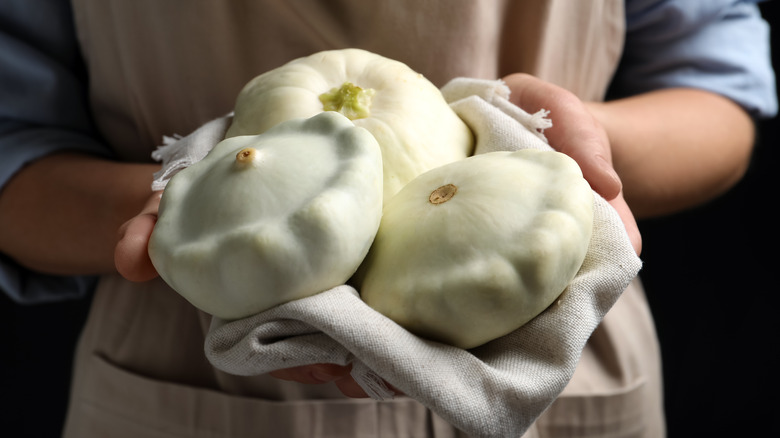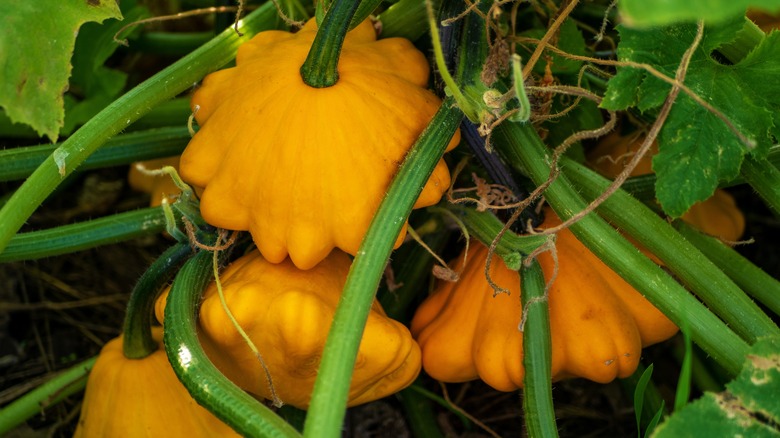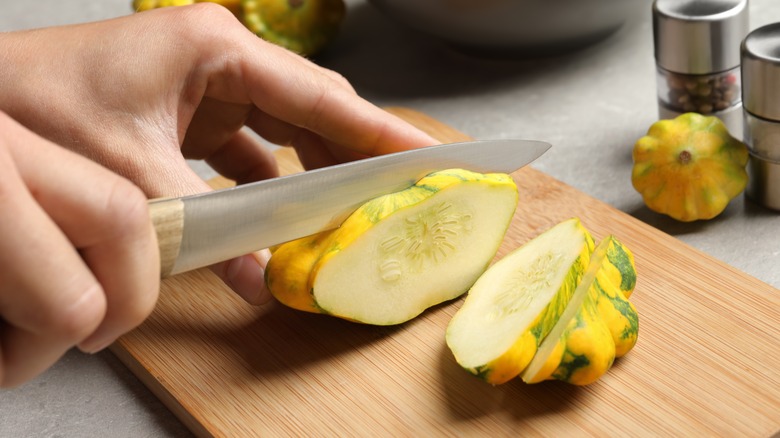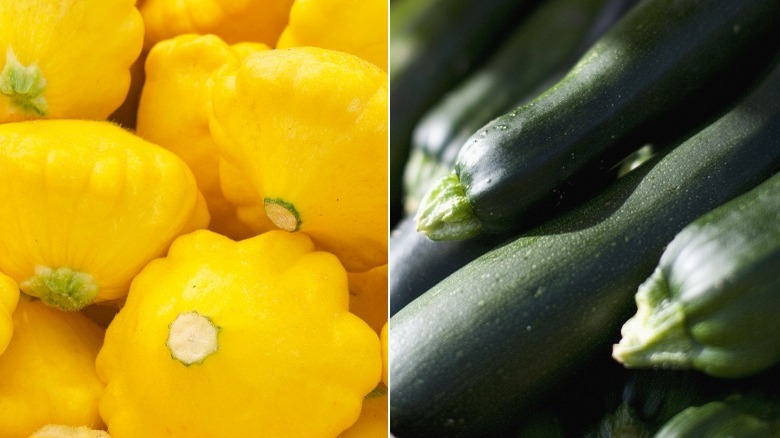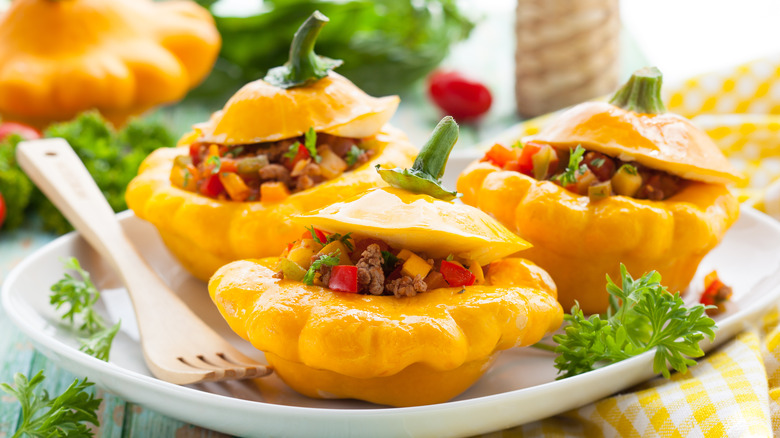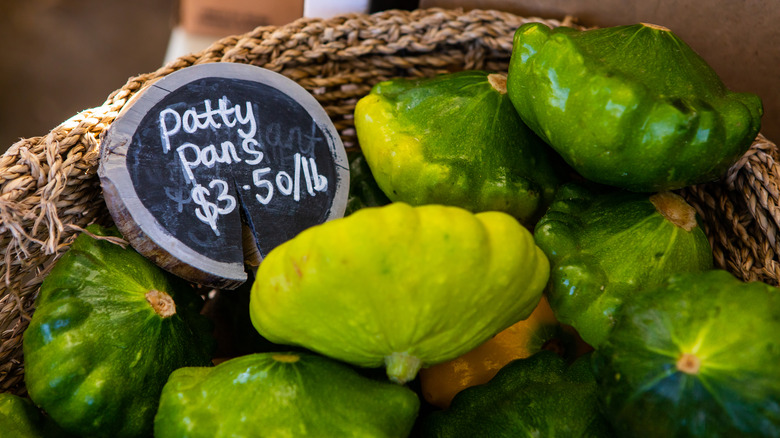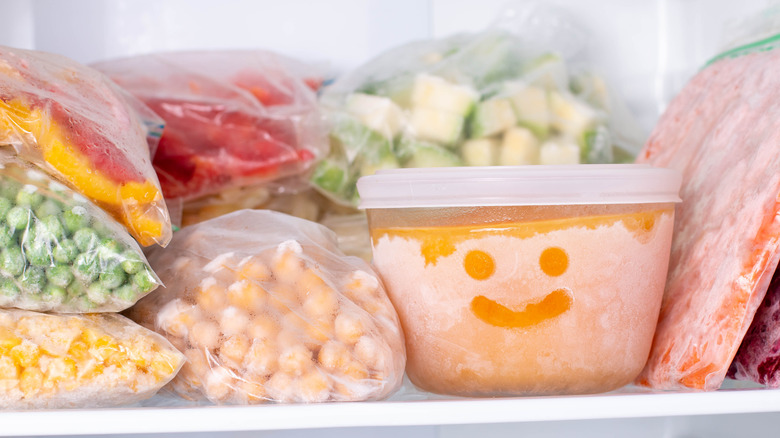What Is Pattypan Squash And How Is It Best Used?
While not as well-known as some of the other summer squashes, pattypan squash (Cucurbita pepo var. clypeata) is as delicious and versatile as they come. These flying saucer-looking fruits may be on the small side, but they pack a punch when it comes to flavor and nutrition. Being unfamiliar with pattypan squash may make some people hesitate to try it, but if you know how to cook summer squash you know how to cook with pattypan squash.
Pattypan squash is also known as scallop squash, cymling squash, patisson squash, tulip squash, custard marrow, and custard squash. Like other summer squashes, the peel is edible and so are the seeds so long as it's picked at the right time. Most summer squashes are picked before they reach full maturity. If pattypan squash is allowed to fully mature, growing to 5 or 6 inches wide, the skin will begin to harden and will need to be peeled. This is pretty unusual, though. Any pattypan squash you buy at the grocery store will likely not have this issue, though you may want to keep it in mind at farmers markets. It's in season from July to September.
What is pattypan squash?
Pattypan squash is a type of summer squash, like zucchini and yellow squash, that grows out wide instead of long. Its unique UFO shape and scalloped edges make it easily identifiable despite the fact that it comes in colors ranging from bright yellow to dark green to orange to white, sometimes even having more than one color.
Pattypan squash is native to Mexico and has been a part of the human diet for centuries. The first record of its cultivation dates to 1591,when Native Americans were reportedly growing them. Cucurbita pepo, the main mother species of most cultivated squash, has been grown as food in the Americas for 8,000 years, so the timeframe of pattypan squash's genuine first cultivation may go back much further.
Due to their high nutritional value, relatively long storage life, and easy cultivation, pattypan squash became very popular when it was introduced to the rest of the world. For reasons that aren't quite clear, the fruit saw a decline in popularity over the past century, although that appears to be changing as the food world continues to hunt for new additions to the kitchen. Speaking of fruit, you may be surprised to discover that pattypan squash is not a vegetable. Like all squashes, including zucchini and pumpkin, pattypan squash is a fruit. It's also edible raw, though you may experience digestive discomfort if you eat too much raw squash at once.
What does pattypan squash taste like?
If you've ever had yellow summer squash, the taste of pattypan squash is quite similar. It has a mild sweetness to it which helps bring a bright summer flair to any dish without overpowering the rest of the ingredients. When raw, it has a slightly crunchy texture similar to zucchini. When cooked, pattypan squash retains its mild sweetness and is even a little better at holding its texture compared to other summer squash, which can get a little soft.
The flavor isn't so mild that it's going to disappear into whatever else you're cooking with it, but that doesn't stop it from being incredibly versatile. Raw pattypan squash can help elevate bright salads with its sweet vegetal profile. If you have a hearty soup, pattypan squash can add some texture and help round out the denser ingredients like beans or meat. Because its flavor profile is so non-confrontational, it really will pair with anything. Throw the kitchen sink onto the stove and make a summer stir fry, if you like.
This is, of course, assuming that it has been harvested at the right time. If allowed to fully develop, the flavors aren't going to wow you in quite the same way. The skin will be tough like a winter squash (think butternut squash) and its flavor will be more like a potato than a zucchini.
Pattypan vs. zucchini
Most people are familiar with zucchini, pattypan squash's more popular cousin, but pattypan is just as charismatic if you let it shine. The similarities are going to outweigh the differences. Both fruits are types of summer squash, a group of squash that are harvested before the skin and seeds become hard. Being so closely related, they both have a similar mild sweetness to them and the same crunchy soft summer squash texture. Pattypan is slightly sweeter and its flesh is slightly denser,but the difference isn't all that noticeable.
All squash originated as wild plants in Central America before being cultivated roughly 8,000 years ago. We already know the origins of pattypan squash, which was first recorded in 1591, but zucchini is actually thought to have originated in 19th-century Italy. At least, the fruit that we know as zucchini today. Different types of squash cross-pollinate remarkably well. Zucchini's parents were brought to Italy from the Americas but were reintroduced to the United States in the 1920s, possibly by Italian immigrants. The introduction of zucchini may be partly to blame for the decline in popularity of pattypan squash, which started around the same time.
How to cook with pattypan squash
Able to be eaten raw or cooked, pattypan squash is a powerhouse of cuisine. Assuming you have a piece of fruit that hasn't reached maturity and hardened up, all you'll need to do is cut off the stem and bottom. From there, it depends on what you're cooking. When raw, slicing it up and putting it in salads is a good way to emphasize its crunchy sweetness.
If you're going to cook it, pattypan squash is best when sautéed, roasted, or grilled. You can cut it into bite-sized pieces, stick them on a skewer, and grill them with a drizzle of vinaigrette. You can chop them up and roast them with other summer veggies tossed in oil, basil, and parsley. Or you can always sautée your squash with lemon and parmesan cheese to use them as a side dish. They also make a great addition to soups. You can make a flavorful puréed pattypan squash soup or you can add slices or chunks to a summer or fall stew. If you have a larger pattypan squash, you can also cut it open, stuff it, and roast it to get a lovely stuffed squash dinner.
Where to buy pattypan squash
The easiest place to buy pattypan squash would be at your local grocery store. Check the produce section next to the other squash for the distinct shape. Not all grocery stores will have it, but it's not so uncommon that it's not worth checking. It may depend on what region you live in, as well.
If you can't find it at your local grocery store, try finding a farmers market when it's in season from July to September. Pattypan is delicious and easy to grow, so someone should have some available. Keep in mind that, compared to a supermarket's available produce, you're more likely to find pattypan squash that has developed past its prime and developed a hard skin at the farmers market.
If the squash is getting close to 5 or 6 inches wide, it may be a sign that it has matured too much. Ask the vendor about it, or, if they seem unsure, opt for squashes that are closer to 3 or 4 inches wide. It will still be edible if it's fully matured but you'll have to peel the skin and the taste won't be as nice.
Nutritional information about pattypan squash
One cup of pattypan squash is roughly 130 grams. With that portion size, you'll be getting 23 calories, making pattypan squash a low-calorie ingredient. But low calorie doesn't mean low nutrition. You'll get a respectable 2 grams of protein and 2 grams of fiber but pattypan squash really stands out when it comes to vitamins and minerals.
You can get nearly a third of your daily recommended intake of vitamin C, with 24 milligrams of the stuff in one cup. It's also a decent source of manganese and folate, which, according to Healthline, promote digestion, bone health, and blood health, among many other benefits. Don't forget its antioxidants like lutein and zeaxanthin.
For being so low in calories, pattypan squash delivers in a big way. You can keep to your weight loss goals without risking a proportionate drop in nutrients. Of course, other summer squash are also low in calories and high in nutrients so it isn't out of character for its family, but that doesn't make it anything less than an excellent addition to a healthy diet.
How to store pattypan squash
Pattypan squash store best in the refrigerator. For the most desirable results, they should not be washed until they're ready to be chopped up and eaten. Place your dry squash in the humidity drawer for two to three days, after which you will see a decline in quality. If you need it to last longer, place the squash in a plastic bag before placing it in the fridge. This way, it will keep for up to seven days.
It should be noted that the smaller the fruit is, the earlier it was likely picked. Younger squash will taste sweeter, but it also means that they haven't developed their protective skin and will go bad faster. If you have several pattypan squash, use the smaller ones first as they will be the first to go.
If you want to freeze them, you'll need to blanch them first. This keeps them from losing their color and flavor due to enzyme activity. Boil a gallon of water and add up to 1 pound of diced pattypan squash. When it begins to boil again, set a timer for three minutes and remove the squash before running them under cold water or placing them in an ice bath. You can also slice and dehydrate pattypan squash if you want longevity without the use of a freezer.
